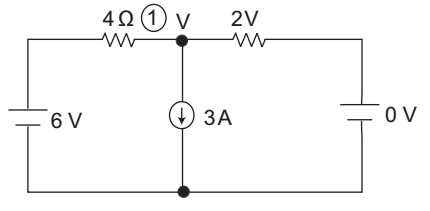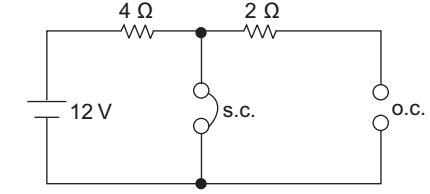Network Elements and the Concept of Circuit
-
What will b e the value of diL for given figure? dt
-
View Hint View Answer Discuss in Forum
As we know that
VL = L diL dt – 2 = 2 diL dt so, diL = –1 H/sec dt Correct Option: B
As we know that
VL = L diL dt – 2 = 2 diL dt so, diL = –1 H/sec dt
- What will be the voltage across the capacitor at t = 0+ for given figure?
-
View Hint View Answer Discuss in Forum
In order to find the voltage across capacitor at t = 0+ the circuit becomes

Note: In this type of question when both C and L are connected in the circuit, we can't apply general formula, because it is very difficult to calculate the time constant τ so we go for tricky method.
Apply KCL at node (1)V - 6 = V - 0 + 3 = 0 4 2 V + V = - 3 4 2 2
or V = – 2 V.Correct Option: B
In order to find the voltage across capacitor at t = 0+ the circuit becomes

Note: In this type of question when both C and L are connected in the circuit, we can't apply general formula, because it is very difficult to calculate the time constant τ so we go for tricky method.
Apply KCL at node (1)V - 6 = V - 0 + 3 = 0 4 2 V + V = - 3 4 2 2
or V = – 2 V.
- Switch S in position (1) for long time and moved to position (2) at t = 0 sec. obtain at t = 0+ the value of i L (0+)—

-
View Hint View Answer Discuss in Forum
At steady state the equivalent circuit becomes

i (0–) =i (0+) = 12 = 3 amp. 4 Correct Option: A
At steady state the equivalent circuit becomes

i (0–) =i (0+) = 12 = 3 amp. 4
- What will be the value of i (t) for t > 0, the circuit shown in figure?

-
View Hint View Answer Discuss in Forum
For t > 0 2 u (– t) ⇒ not exist while 50 u (t) → exist, so the circuit becomes like

i (∞) = - 50 = – 2.5 amp. 20
i (0–) = i (0+) = 1 amp.τ = L = .2 = .01 R 20
we know that
i (t)=[i (0) – i (∞)] e –t / τ + i (∞) .....(i)
on putting the values in equation (i), we get
i (t) = [1 – (– 2.5)] e – t .01 – 2.5Correct Option: A
For t > 0 2 u (– t) ⇒ not exist while 50 u (t) → exist, so the circuit becomes like

i (∞) = - 50 = – 2.5 amp. 20
i (0–) = i (0+) = 1 amp.τ = L = .2 = .01 R 20
we know that
i (t)=[i (0) – i (∞)] e –t / τ + i (∞) .....(i)
on putting the values in equation (i), we get
i (t) = [1 – (– 2.5)] e – t .01 – 2.5
- The value of i (t) < 0 is given by the relation for the circuit shown below—

-
View Hint View Answer Discuss in Forum
For t < 0, 50 u (t) → not exist, so the circuit becomes like

i L (0–) = i L (0+) = 2 × 10 = 1 amp. 10 + 10
so, i (t) = 1 u (– t)Correct Option: D
For t < 0, 50 u (t) → not exist, so the circuit becomes like

i L (0–) = i L (0+) = 2 × 10 = 1 amp. 10 + 10
so, i (t) = 1 u (– t)

